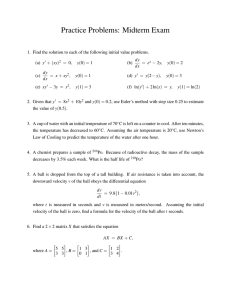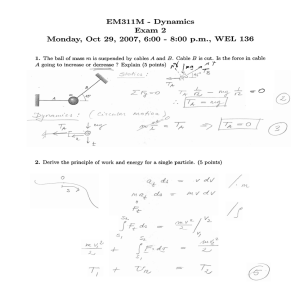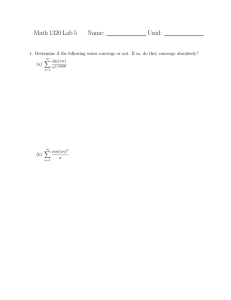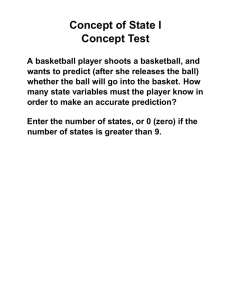Physics I – Exam 2 – Spring 2003 Answer Key
advertisement
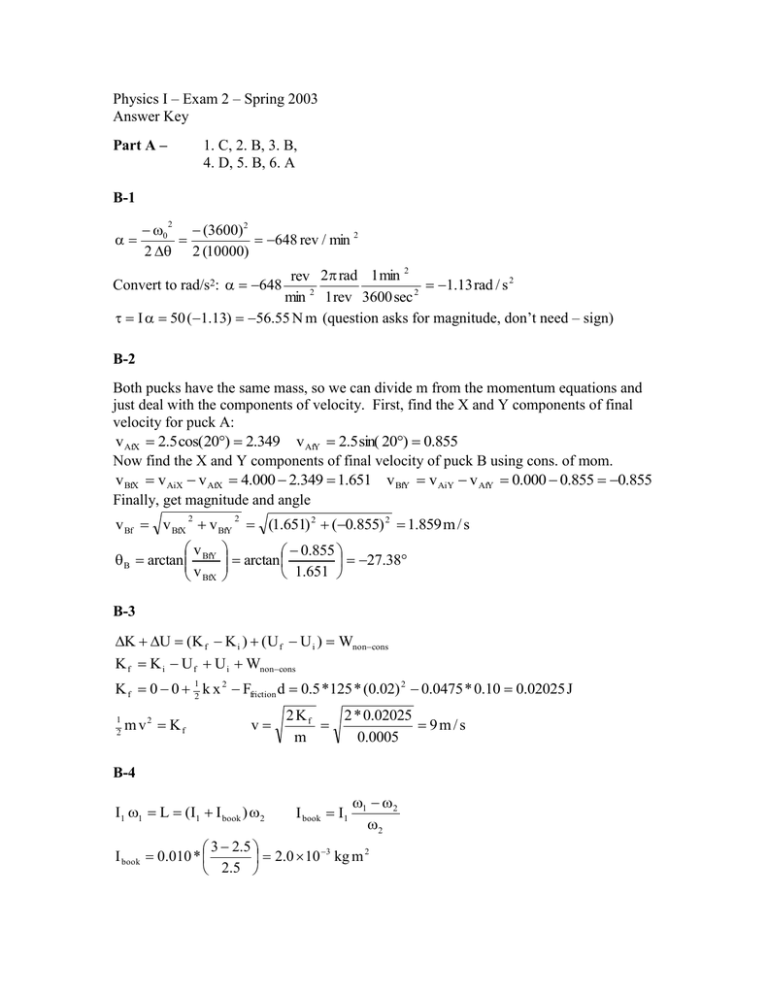
Physics I – Exam 2 – Spring 2003 Answer Key Part A – 1. C, 2. B, 3. B, 4. D, 5. B, 6. A B-1 0 (3600) 2 648 rev / min 2 2 2 (10000) 2 rev 2 rad 1 min 2 1.13 rad / s 2 2 2 min 1 rev 3600 sec I 50 (1.13) 56.55 N m (question asks for magnitude, don’t need – sign) Convert to rad/s2: 648 B-2 Both pucks have the same mass, so we can divide m from the momentum equations and just deal with the components of velocity. First, find the X and Y components of final velocity for puck A: v AfX 2.5 cos(20) 2.349 v AfY 2.5 sin( 20) 0.855 Now find the X and Y components of final velocity of puck B using cons. of mom. v BfX v AiX v AfX 4.000 2.349 1.651 v BfY v AiY v AfY 0.000 0.855 0.855 Finally, get magnitude and angle v Bf v BfX v BfY (1.651) 2 (0.855) 2 1.859 m / s 2 v B arctan BfY v BfX 2 0.855 arctan 27.38 1.651 B-3 K U (K f K i ) ( U f U i ) Wnoncons K f K i U f U i Wnoncons K f 0 0 12 k x 2 Ffriction d 0.5 *125 * (0.02) 2 0.0475 * 0.10 0.02025 J 1 2 m v2 Kf v 2 Kf 2 * 0.02025 9m/s m 0.0005 B-4 I1 1 L (I1 I book ) 2 I book I1 1 2 2 3 2.5 3 2 I book 0.010 * 2.0 10 kg m 2 . 5 C-1 A. I TOTAL I student I stool I ball 1.4 0.1 m ball r 2 I TOTAL 1.4 0.1 m ball r 2 1.5 0.1 * (0.8) 2 1.564 kg m 2 B. Positive direction for angular momentum is UP. The angular momentum of the ball (before it is caught) is in the negative (DOWN) direction. L before L studentstool L ball (I student I stool ) before r m ball v ball L before (1.4 0.1) * 4 0.8 * 0.1 *16.35 4.692 kg m 2 / s L 4.692 after 3 rad / s L before L after I TOTAL after I TOTAL 1.564 C-2 The warning in the problem is clear that it is incorrect to do this problem with the concept of “average acceleration” or “average force”. The correct solution of this problem requires the Impulse-Momentum Theorem and the Work-Energy Theorem. Let the +X direction be east and the +Y direction be north. The initial momentum is p Xi m v 10 kg m / s. p Yi 0 The impulse changes the momentum: p Xf p Xi J X 10 18 8 kg m / s. p Yf p Yi J Y 0 6 6 kg m / s Divide by mass to get velocity and get the final speed. v Xf p Xf / m 8 / 2 4 m / s. v Yf p Yf / m 6 / 2 3 m / s v f v Xf v Yf (4) 2 (3) 2 5 m / s Since the speed did not have a net change, only the direction of velocity, the final and initial kinetic energies are equal. Therefore, by the Work-Energy Theorem: The force did no (zero) net work over the specified time interval. Answer = 0 J. 2 2


